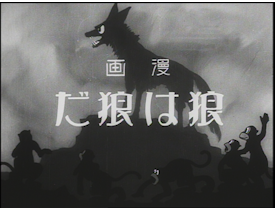Experts' choice
Various experts introduce their own selection of the works on JAFC.
- List of Works
- Various Rankings
- Characters selection
- Experts' choice
- FAQ about the films
Fukuzumi Ren(Art critic)
Art critic. Fukuzumi has created many works, including Contemporary Fringe Art (BankART 1929, 2008), Collection of Japanese Arts (Vol. 19): Expanding Post-war Art (Shogakkan, 2015) (co-author), Traveling with Enku (Bijutsu Shuppan-sha, 2015), and Animal Language (Hatori Press, 2016).
Fukuzumi Ren's choice
- Choice reason of the work
- We cannot ignore nuclear risks when developing post-3/11 philosophy. How can we capture the risks of invisible and even imperceptible radiation? We can depend only on our imagination. This is why art has an ever more important role to play in contemporary society. This animated film was created for the purpose of spreading hygienic knowledge. By giving a visible form to invisible germs, the film shows their threat and how to get rid of them. It is extremely frightening to see how pathogens carried by cute little characters spread from person to person. However, this film does not visualize a crucial aspect—i.e., the immune system, which is also invisible, that fights against germs inside the human body. This film makes us face the undeniable fact that an invisible world always lies beyond our world no matter how much it is visualized.
- Choice reason of the work
- Shinpei Goto (1857-1929) was a politician who was active during the Meiji, Taisho, and early Showa periods. He served as the Governor-General of Taiwan and the first president of the South Manchurian Railway Company, where he supported the invasion of China by Imperial Japan. After the Great Kanto Earthquake, Goto worked as the Interior Minister and President of the Imperial Capital Reconstruction Council to draft the plan for the reconstruction of Tokyo, which was devastated by the earthquake. The framework of the present-day Tokyo was established mostly by Goto. This animated film was made based on a political speech delivered by Goto. It is a work created approximately 90 years ago. Nevertheless, interestingly enough, it provides a strong sense of contemporary reality. Not only does the arrow icon used to guide the audience's gaze look like a cursor, but Goto's speech that emphasizes the importance of constitutionalism sounds particularly convincing today, when it is threatened.
- Choice reason of the work
- For Japanese people, the wolf is an ambivalent animal. Although it is feared as an animal that threatens our lives, it is also often worshiped as a sacred animal. Many folktales and old stories that are passed down through generations in local communities tell us about the mutually beneficial relations between humans and wolves, such as a gift delivered by a wolf saved from a pit by a human. In this film the wolf is depicted from a one-sided perspective as a violent villain that attacks other wild animals. However, it needs to be noted that the wolf in this film sometimes walks on two legs like a human. This is no doubt personification of animals frequently used in animated films and comics. However, it may also suggest the ambiguity of the wolf. If so, the wolf is not only evil, but also divine—all the more so because he is evil.
selection of the works 1Yamamoto Sanae『Diseases Spread』(1926)
selection of the works 2『Kouchi Junichi "Film Address "Ethicization of Politics" by Shinpei Goto, 1926"』(1926)
selection of the works 3Murata Yasuji『A Wolf is a Wolf』(1931)
Please tell us what you think about this website by filling out a short questionnaire.
To educational users: Please provide us with feedback on website usage for educational purposes.
- Unauthorized copying and replication of the contents on this site are prohibited.


